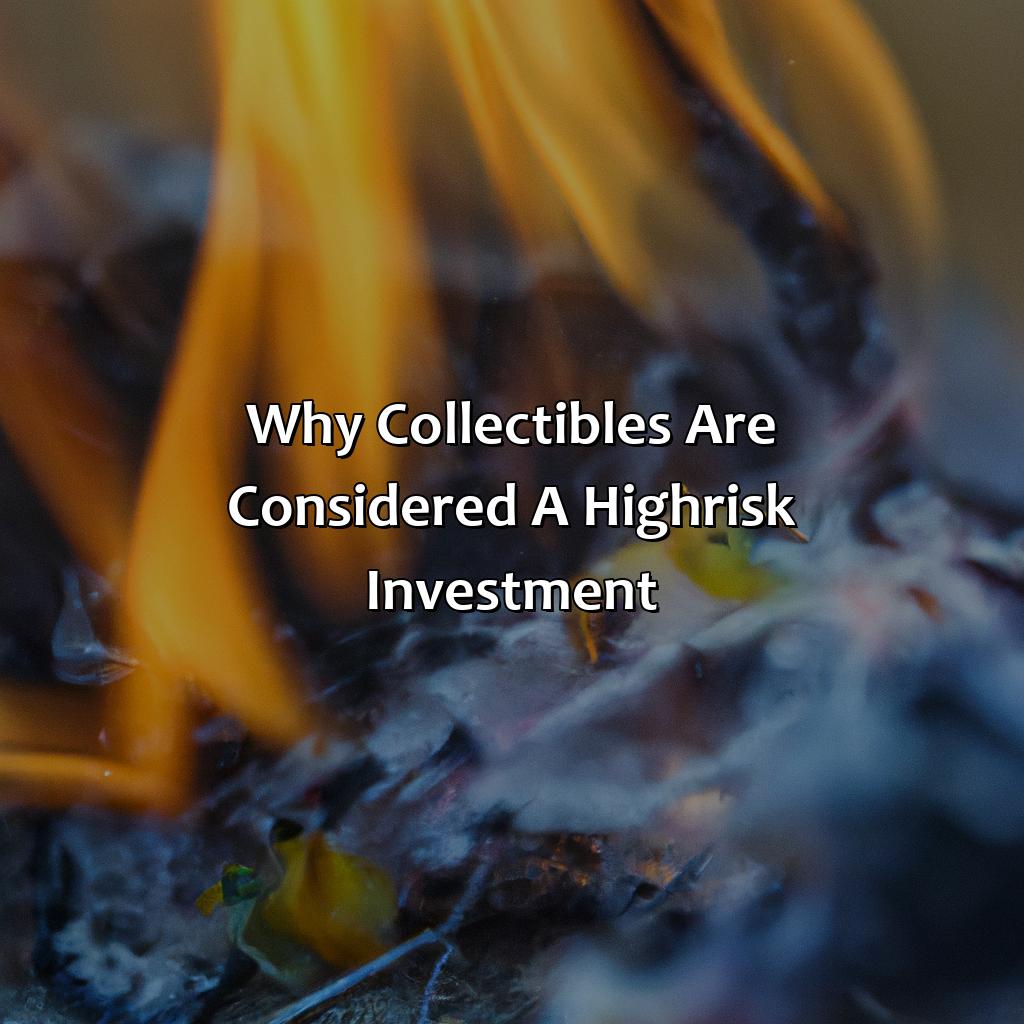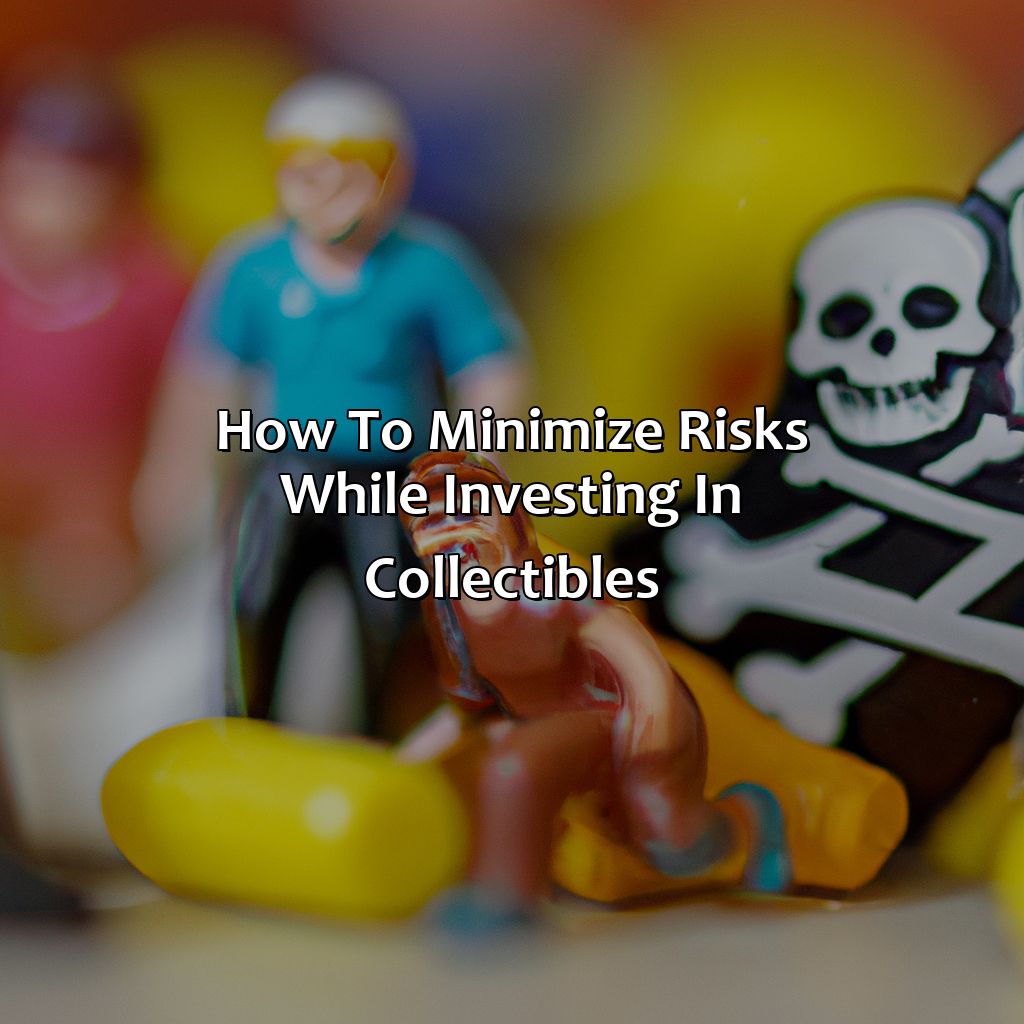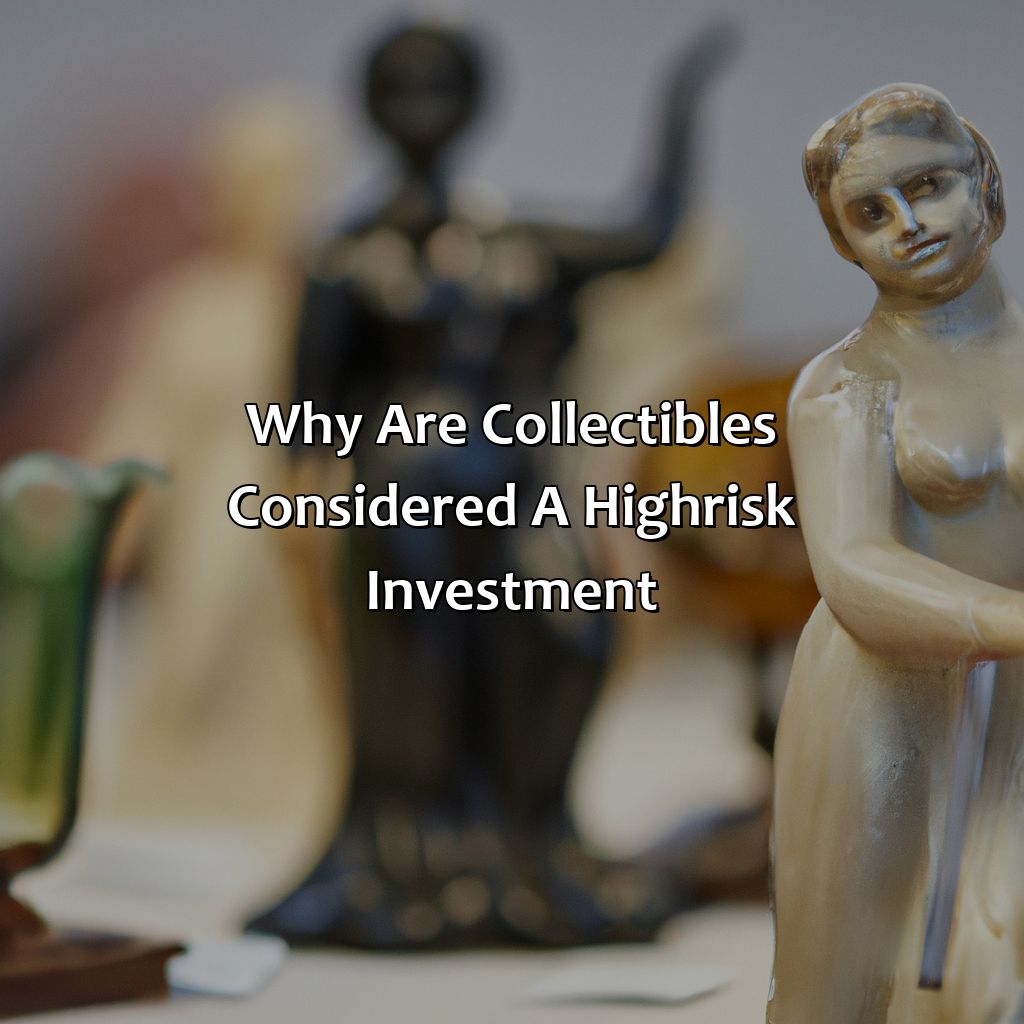Why Are Collectibles Considered A High-Risk Investment?
Key Takeaways:
- Collectibles are considered a high-risk investment because of their rarity and authenticity, which can make them difficult to value accurately and subject to fluctuations in demand.
- Market demand and supply also impact the value of collectibles and can change rapidly, making it difficult to predict their future worth.
- Collectibles often have limited liquidity, meaning they cannot be sold quickly or easily without significant price reductions, increasing the risk of losses and reduced returns.
- Investing in collectibles can also carry potential for damage or loss, making it important to take steps to protect and insure the items in your portfolio.
- To minimize risks while investing in collectibles, it is important to avoid fakes and scams through careful research and authentication, diversify your portfolio to spread risk, and seek professional advice from experienced appraisers and collectors.
Feeling overwhelmed by the risks associated with investing in collectibles? You’re not alone. Even experienced collectors can be intimidated by the unpredictable nature of collectible investments – but understanding the potential rewards can help ease your concerns. In this blog, we explore why collectibles may be a high-risk investment.
Why collectibles are considered a high-risk investment?
Why collectibles are a high risk investment?
Rarity and authenticity are the factors which decide value. Market demand and supply set the price. Liquidity is limited, making it hard to sell fast. Plus, damage or loss can reduce their worth drastically.

Image credits: retiregenz.com by Joel Jones
Rarity and authenticity
The scarcity and genuineness of collectibles are integral aspects that classify them as high-risk investments. Rarity ensures demand, while authenticity builds trust amongst investors. A lack of rarity lowers the value of the collectible, while false authentication renders the investment worthless.
Collectibles’ rarity is determined by factors such as age, historical significance, and limited production. The uniqueness associated with such objects naturally drives up their prices in the market. Authenticity refers to an object’s origin and provenance, which must be verified to increase its worth.
Investors need to consider multiple variables in determining a collectible’s potential value before investing in it. Despite being high-risk, these unique items can fetch huge returns if obtained at the right price and sold at an opportune moment.
It is estimated that there has been a surge of over 130% in crypto art sales since October 2020.
Collectibles may be rare, but their demand and supply are like a seesaw – constantly fluctuating and keeping investors on their toes.
Market demand and supply
The interplay between the demand and supply of collectibles is a crucial factor in determining their worth. The rarity, condition, and provenance of these items influence their value in the market, making them a high-risk investment. Additionally, the subjective nature of collectibles’ worth is another factor that adds to the risk.
It’s essential to understand that no two collectibles are alike, making it difficult to predict their future value. Furthermore, changes in popular culture and trends can significantly impact the demand for these items and, in turn, their market value.
Collectibles’ potential to become obsolete or lose their charm over time also contributes to their high-risk status as an investment. The market can be fickle when it comes to collectibles; investors must have a long-term perspective and a deep understanding of trends.
For instance, Beanie Babies were one of the most popular collectible crazes in the 1990s. However, after the hype fizzled out and newer toys entered the market, many collectors lost money on their investments.
Overall, while investing in collectibles can offer significant gains for those with a keen eye for detail and foresight into emerging trends, it’s crucial to note that they come with inherent risks due to their subjective nature and dependence on market demand and supply.
You can’t cash in your collectibles for rent, but you can build a pretty impressive fort with them.
Limited liquidity
The illiquidity of collectibles remains a key factor in their high investment risk. Selling these items or converting them into cash can be challenging, as the market for collectibles is generally smaller and more volatile than traditional investments. This means that it may take longer to convert collectibles into cash compared to other assets.
Moreover, buyers and sellers must rely on dealers, auction houses, or other intermediaries to facilitate transactions. These intermediaries may charge high fees for their services, which can further reduce returns on investments in collectibles.
In addition to limited liquidity, the authenticity and condition of collectibles are also important factors to consider when investing in these items. Collectibles that turn out to be fraudulent or damaged can lead to significant losses for investors.
A prominent example is the case of Modigliani paintings sold by a French collector named Christian Parisot. The paintings were initially valued at $89 million, but it was found that some of them were fake. As a result, the entire collection was sold for less than $20 million – a significant loss for Parisot and his investors.
Collectibles may hold emotional or sentimental value for some individuals; however, they pose unique risks as an investment option due to their limited liquidity and reliance on intermediaries. Investors should carefully consider these risks before investing in this asset class.
Your collectibles can be worth a lot of money, but they’re also just one clumsy move away from becoming a pile of expensive rubble.
Potential for damage or loss
Collectibles are considered a precarious investment due to the potential risk of damage or loss. Collectibles like art, antiques and other rare items require careful handling and conservation to retain their value. Damage or loss can occur during transportation, display, storage, or even through neglect. Insurance may offer some protection against such events but may also be costly.
Moreover, collectibles may not have a predictable resale value in the market. The worth of these assets is often subjective and dependent on factors such as their condition, rarity and desirability among collectors – which may fluctuate over time. This unpredictability increases the risk for investors who may not be able to get the same return on investment as they had initially estimated.
It’s important to note that collectors’ items may not provide any financial returns at all and are sometimes pursued purely for personal satisfaction. Also, certain collectible categories such as coins and stamps have established markets with a history of consistent returns.
Still, there are many cases where collectors have lost money due to various factors including counterfeits, overvaluation by auction houses or fraudulent activity by sellers – highlighting the high-risk nature of investing in collectibles.
In 2016, Leonardo da Vinci’s “Salvator Mundi” painting was sold for a record-breaking $450 million at Christie’s auction house. However, recent reports suggest that the painting has not been seen publicly since it was sold leading to questions on its whereabouts and condition- further highlighting the unpredictable nature of investing in collectibles.
Protect your precious collectibles like they’re your first-born child, but without the diaper changes and constant crying.
How to minimize risks while investing in collectibles?
Minimizing risks of collecting? Seek professional advice!
Diversify portfolios for better chances. To evade fakes and scams, here are strategies to reduce risks and up success in collecting investments.

Image credits: retiregenz.com by Harry Woodhock
Avoiding fakes and scams
To Safeguard Your Investment in Collectibles
Collectibles, being a high-risk investment, demand attention and care to minimize the risks. It is crucial to spot counterfeit items and avoid scams to ensure your investment’s safety. Here are some tips:
- Always authenticate collectibles from professionals.
- Check for subtle differences in branding and colors.
- Analyze packaging and labels for discrepancies.
- Purchase from reputable retailers or dealers only.
- Research prices to avoid overpaying or under-pricing a valuable item.
- Secure proper documentation, i.e., receipt and certificate of authenticity.
Furthermore, it is advisable to stay up-to-date with market trends and check independent, authenticating agencies’ certifications before investing.
Pro Tip: Take pictures of your valuable possessions, keep proof of purchase safe, and periodically verify the collectible’s authenticity to avoid any unpleasant surprises.
Collectibles may be high risk, but diversifying your collection can help prevent a total meltdown of your portfolio.
Diversifying the portfolio
Investing in a single collectible item can be a risky endeavor, as the value of such items is subject to market fluctuations. To reduce risks and increase the chances of success, diversifying your portfolio by investing in multiple collectible asset classes is essential. A diverse collection can include rare books, coins, stamps, vintage toys, sports memorabilia and art pieces to name a few.
By having different types of collectibles in your portfolio, you can better spread out risk and avoid being too heavily invested in any one item or market segment. For instance, if there happens to be a significant downturn in the sports memorabilia market – but your collection also includes rare coins or limited edition figurines – you’ll have some built-in risk mitigation measures that ensure your investment remains worthwhile.
It’s important to note that while diversification helps minimize risk somewhat; there’s never any guarantee on returns. That’s why it’s vital to stay current on trends within each asset type and keep track of how each individual item is performing over time.
According to Forbes magazine, most experts agree that high-value art investments require assembling diversified collections gradually over an extended period rather than buying individual pieces at auction sites or private dealerships.
Before seeking professional advice on collectible investments, make sure they don’t also specialize in selling ‘vintage’ beanie babies on the side.
Seeking professional advice
To mitigate risks while investing in collectibles, consider obtaining guidance from an industry expert. Consulting a professional can aid in valuing items, selecting high-quality goods, and avoiding fraud amidst a competitive market. Additionally, seeking advice can provide assurance when deciding to allocate capital towards rare or vintage pieces.
It is essential to remember that even with expert counsel, no investment guarantees success nor does it eliminate all risk. Therefore, focus on building an extensive collection that is diversified across various asset classes and vintages.
According to Forbes, “collecting art is an emerging area of wealth management” (Martin, 2021).
Five Facts About Why Collectibles Are Considered a High-Risk Investment:
- ✅ Collectibles have no intrinsic value and are subject to fluctuations in demand. (Source: Investopedia)
- ✅ The market for collectibles is often subject to bubbles, leading to overinflated prices and subsequent crashes. (Source: The Balance)
- ✅ The authenticity and condition of collectibles can be difficult to verify, leading to potential fraud and forgeries. (Source: Forbes)
- ✅ Collectibles are often illiquid, meaning they cannot be easily sold for cash. (Source: U.S. News & World Report)
- ✅ Collectibles do not offer any dividends or interest, making them a purely speculative investment. (Source: The Motley Fool)
FAQs about Why Are Collectibles Considered A High-Risk Investment?
Why are collectibles considered a high-risk investment?
Collectibles are considered a high-risk investment because their value is subjective and dependent on factors such as historical significance, rarity, and condition. Unlike traditional investments, collectibles do not have a set market value and can be difficult to resell at a profit.
What types of collectibles are considered high-risk investments?
High-risk collectibles include items such as artwork, coins, stamps, and sports memorabilia. These items often have a limited market and may require specialized knowledge to accurately value and authenticate.
Can you lose money investing in collectibles?
Yes, you can lose money investing in collectibles. Unlike traditional investments, collectibles do not have a guaranteed return on investment, and their value can fluctuate based on factors beyond your control.
What are some strategies for minimizing risk when investing in collectibles?
Some strategies for minimizing risk when investing in collectibles include conducting thorough research on the item and its market, working with reputable dealers and authenticators, ensuring the item’s condition is accurately assessed, and diversifying your investment portfolio.
What are some common mistakes people make when investing in collectibles?
Common mistakes people make when investing in collectibles include not conducting enough research, overpaying for items based on emotion rather than market value, failing to accurately assess the item’s condition, and not diversifying their investment portfolio.
Is it ever a good idea to invest in collectibles?
It can be a good idea to invest in collectibles as part of a diverse investment portfolio. However, it is important to approach these investments with caution and to thoroughly research and evaluate potential purchases before investing.
